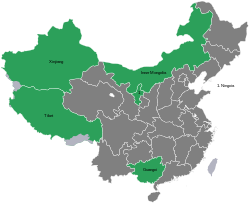
Back مناطق الحكم الذاتي في الصين Arabic Rexón autónoma de China AST Автономни региони в КНР Bulgarian চীনের স্বায়ত্তশাসিত অঞ্চল Bengali/Bangla ཀྲུང་གོའི་རང་སྐྱོང་ལྗོངས། Tibetan Regions autònomes de la Xina Catalan Autonomní oblasti v Číně Czech Autonome Region (China) German Αυτόνομες περιοχές της Κίνας Greek Aŭtonomaj regionoj de Ĉinio Esperanto
This article needs additional citations for verification. (October 2018) |
| Autonomous regions 自治区 Zìzhìqū | |
|---|---|
 | |
| Category | Unitary state |
| Location | China |
| Number | 5 (Guangxi, Inner Mongolia, Ningxia, Tibet, and Xinjiang) |
| Populations | 110,879,058[a] |
| Areas | 4,380,000 km2 (1,690,000 sq mi)[b] |
| Government |
|
| Subdivisions | |
| Administrative divisions of China |
|---|
|
History: before 1912, 1912–49, 1949–present Administrative division codes |
The autonomous regions (Chinese: 自治区; pinyin: Zìzhìqū) are one of four types of province-level divisions of China. Like Chinese provinces, an autonomous region has its own local government, but under the law of the People's Republic of China, an autonomous region has more legislative rights, such as the right to "formulate self-government regulations and other separate regulations."[1] An autonomous region is the highest level of minority autonomous entity in China, which has a comparably higher population of a particular minority ethnic group.
There are five autonomous regions in China: Guangxi, Inner Mongolia (Nei Menggu), Ningxia, Tibet (Xizang), and Xinjiang.
Cite error: There are <ref group=lower-alpha> tags or {{efn}} templates on this page, but the references will not show without a {{reflist|group=lower-alpha}} template or {{notelist}} template (see the help page).
- ^ "Regional Autonomy for Ethnic Minorities in China (2005)". english1.english.gov.cn. Archived from the original on 2021-05-01. Retrieved 2021-07-07.